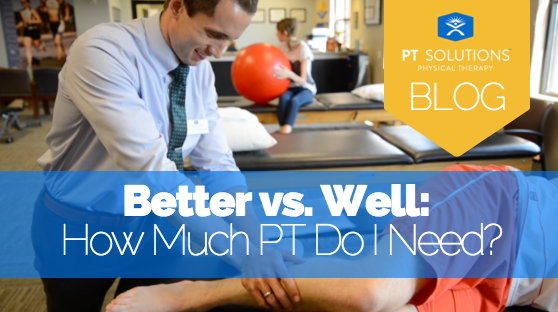Better vs. Well: How Much PT Do I Need?

It is important to understand that the body is very complex. There are many factors involved when trying to change its condition in a positive way. Let’s say your back started bothering you two weeks ago while working on your computer. What is your next step? As stated in previous posts I’ve written, it is vital that you seek physical therapy as soon as possible to address the issue while it is still in the beginning stages. Your physical therapy program should consist of intervention in many respects. Among them: exercise, nutrition, sleep, stress, and pain science. There is one unanswered question that is under constant debate. How long do you really need to be in physical therapy?
The mindset has long been that pain is an indicator of dysfunction. If someone is hurting then there must be a problem, yet if an individual is not in pain then everything is fine. Unfortunately this is far from the truth. The moment you feel pain in your low back is not the moment your back was first injured. Muscle atrophy (decrease in muscle size), cartilage fraying, inflammation, joint damage, all have been developing over time. Experiencing pain is just your body’s recognition that there is a problem and it is now sounding the alarm.
Just as it takes time to develop dysfunction, it takes a while for it to heal as well, often times longer. Your body will start to atrophy in as little as 3 days (ever seen an arm or leg after a cast was removed?) while it takes a few months for muscle hypertrophy (increase in muscle size). If you reposition in your chair or go for a 5-minute walk then return to work pain free, that does not mean your back magically healed. Your muscle is still atrophied, the cartilage is still frayed, inflammation is still present, and joint damage still exists. I don’t say these things to scare you and express no hope. I am stressing the importance of addressing the underlying issue and not simply looking at pain to determine if your body is recovered or not. This brings us to the main question. Is your rehabilitation making you better or well?
How many times have you re-injured a part of your body you thought healed? While there are some injuries that are at greater risk for reoccurring after an initial injury (such as tearing a muscle or twisting an ankle) those risks can mitigate through proper rehabilitation. Other times it is the same injury that was never completely treated. As physical therapists, our goal is not to eliminate your pain, but to eliminate your dysfunction. It just so happens that eliminating the dysfunction eliminates the pain (not the other way around). It takes time for muscle to hypertrophy and motor learning to take place. Several manual therapy techniques can be used to make you feel better after a single physical therapy session, which is great, but that shouldn’t be the end of treatment! Now the stage is set to complete therapeutic exercise to truly address the issue.
A skilled physical therapist will be able to determine the underlying dysfunction and help you address it. You may have heard the terms “corrective exercises” and “muscle imbalances.” Those have their place in the rehabilitation process, but it is more than that. Exercise needs to not only be the appropriate type, but it also needs to be at a high enough intensity and duration. Make sure you are seeing a physical therapist that will work you hard enough to achieve the change you need.
Now back to the original question. How long do you need to be in PT? That is going to depend on your injury and the plan you develop with your physical therapist. However, it shouldn’t last only a couple weeks and then a home exercise program. Physical therapy is more effective than home exercise programs as proven numerous times in research. It may take a few months to create the physiologic change your body needs, but then you won’t have to worry about that nagging pain you have been dealing with returning. I encourage you to seek the appropriate care you need and to stick with it until the end. Be sure you are addressing the actual problem and fully correcting it.
About the Author
Zach Walston (PT, DPT, OCS) grew up in Northern Virginia and earned his Bachelor of Science in Human Nutrition, Foods, and Exercise at Virginia Polytechnic Institute and State University. He then received his Doctorate of Physical Therapy from Emory University before graduating from the PT Solutions’ Orthopaedic Residency Program in 2015.
Zach has numerous research publications in peer-reviewed rehabilitation and medical journals. He has developed and taught weekend continuing education courses in the areas of plan of care development, exercise prescription, pain science, and nutrition. He has presented full education sessions at APTA NEXT conference and ACRM, PTAG, and FOTO annual conferences multiple platforms sessions and posters at CSM.
Zach is an active member of the Orthopedic and Research sections of the American Physical Therapy Association and the Physical Therapy Association of Georgia. He currently serves on the APTA Science and Practice Affairs Committee and the PTAG Barney Poole Leadership Academy.